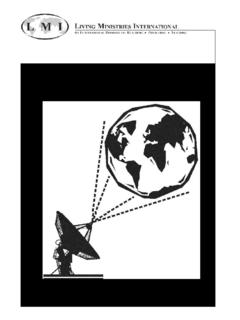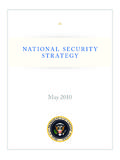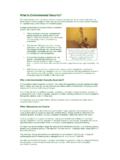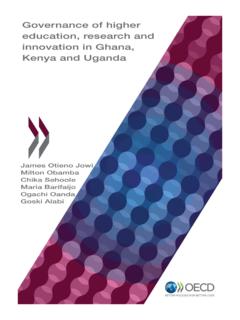Transcription of Industrial Development for the st - United Nations
1 DEPARTMENT OF ECONOMIC AND SOCIAL AFFAIRSI ndustrial Developmentfor the 21stCentury:Sustainable Development PerspectivesasdfUNITED NATIONSNew York,2007 DESAThe Department of Economic and Social Affairs of the United NationsSecretariat is a vital interface between global policies in the economic, socialand environmental spheres and national action. The Department works inthree main interlinked areas: (i) it compiles, generates and analyses a widerange of economic, social and environmental data and information on whichStates Members of the United Nations draw to review common problemsand to take stock of policy options; (ii) it facilitates the negotiations ofMember States in many intergovernmental bodies on joint course of actionto address ongoing or merging global challenges.
2 And (iii) it advises interest-ed Governments on the ways and means of translating policy frameworksdeveloped in United Nations conferences and summits into programmes atthe country level and, through technical assistance, helps build views expressed in the articles are those of the individual authors and donot imply the expression of any opinion on the part of the United designations employed and the presentation of the material in this pub-lication do not imply the expression of any opinion whatsoever on the partof the Secretariat of the United Nations concerning the legal status of anycountry, territory, city or area or of its authorities, or concerning the delim-itation of its frontiers or term country as used in the text of this publication also refers, asappropriate, to territories or designations more developed , less developed and least developed countries, areas or regions are intended for statistical convenience and do notnecessarily express a judgement about the stage reached by a particular coun-try or area in the Development the United Nations Conference on Environment and Development in1992 and the subsequent World Summit on Sustainable Development in2002, significant efforts have been made in pursuit of sustainable develop-ment.
3 At the September 2005 World Summit, the UN General Assemblyreiterated that sustainable Development is a key element of the overarchingframework for United Nations activities, in particular for achieving the inter-nationally agreed Development goals , including those contained in theMillennium Declaration and the Johannesburg Plan of Implementation(A/RES/59/227).The United Nations Commission on Sustainable Development (CSD)will be holding its 15th session in the spring of 2007, focusing on policyoptions and practical measures to address challenges in the areas of energy forsustainable Development , Industrial Development , air pollution/atmosphere,and climate change.
4 This is clearly a very ambitious agenda and the issues arerather closely interlinked. Yet, the Commission will also need to consider eachof these topics on its own terms. In order to inform the discussions onIndustrial Development , the Division for Sustainable Development , whichacts as Secretariat to the Commission, is publishing this book, which high-lights key challenges for developing countries, across different regions and sec-tors, and how effectively and with what sorts of policies different countrieshave responded to them. At the same time, the topics addressed in the volumeare directly relevant to the preparations for the next two-year cycle, morespecifically to the themes "agriculture", "rural Development ", and Africa.
5 The volume begins by examining Industrial Development as central tothe process of structural transformation which characterises economic devel-opment. It points to the new challenges and opportunities facing today sindustrialisers as a result of globalization, technological change and newinternational trade rules. The emergence of Southern multinationals andSouth-South investment is one new phenomenon explored. The next set ofchapters focuses on key sectors with potential for developing countries. Twokey themes emerge. First, traditional points of entry for late industrialisers like textiles and clothing have become even more intensely competitivethan before, calling for innovative adaptive strategies.
6 Second, countries maywish to broaden their Development perspective, recognizing that industry narrowly defined does not exhaust the opportunities for producing highvalue added goods and services for international markets. Knowledge inten-sity is increasing across all spheres of economic activity, including agricultureand services which can offer promising Development paths for some develop-ing countries. The final section addresses social and environmental aspects ofivIndustrial Development for the 21st Centuryindustrial Development . Much evidence is presented that labour-intensive but not necessarily other patterns of Industrial Development can be highlyeffective in poverty reduction. A range of policies can promote industrialenergy and materials efficiency, often with positive impacts on firms finan-cial performance as well as the environment.
7 Promoting materials recyclingand reuse is found to be an effective if indirect means of conserving , the growth of multinational interest in corporate social responsibili-ty is traced, with consideration given to both the barriers and the opportu-nities this can pose for developing country enterprises linked to global sup-ply chains. We hope that this collective effort of staff members and external authorscontributes to a successful outcome of CSD-15. JoAnne DiSanoDirector, Division for Sustainable DevelopmentvAcknowledgementsThis book benefited from critical feedback received at an Expert GroupMeeting in September 2006 where draft chapters were reviewed and dis-cussed. A number of specialists in different aspects of Industrial developmentparticipated in the brainstorming on policy lessons , and many of thoseinsights are incorporated in the concluding chapter.
8 Special thanks are dueto those who participated in the aforementioned meeting as paper discus-sants, including Jomo K. Sundaram, Rob Vos, Manuel Montes, RalphWahnschafft and David Le Blanc of UNDESA, and Dilek Aykut of TheWorld Bank. The contribution of Under-Secretary General Jos AntonioOcampo, who kindly agreed to have a summary of his comprehensive open-ing remarks included as an introduction to the volume, is gratefully acknowl-edged. viiContentsForeword,JoAnne DiSano .. ,Jos Antonio 1 New Frontiers and Challenges Development : Some stylized facts and policy directions,Dani Rodrik .. Technology, globalization, and international competitiveness:Challenges for developing countries,Carl Developing country multinationals: South-South investment comes of age,Dilek Aykut and Andrea 2 Sector resource-based industries: Prospects for Africa s agriculture,M nica Kj llerstr m andKledia textiles and clothing industry: Adjusting to a post quota world,Ratnakar Adhikariand Yumiko Services-led industrialization in India: prospects and challenges,Nirvikar 3 Social and Environmental Dimensions of Industrial Development and economic growth:Implications for poverty reduction and income inequality,Matleena Kniivil.
9 Energy and materials efficiency: What role for policies?,Mohan Peck andRalph From supply chains to value chains: A spotlight on CSR,Malika Bhandarkar andTarcisio Way ForwardPolicy lessons for 21st century industrializers David O Antonio Ocampo*Economic Development is fundamentally a process of structural transforma-tion1. This involves the reallocation of productive factors from traditionalagriculture to modern agriculture, industry and services, and the reallocationof those factors among Industrial and service sector activities. If successful inaccelerating economic growth, this process involves shifting resources fromlow- to high-productivity sectors. More broadly, sustained economic growthis associated with the capacity to diversify domestic production structure:that is, to generate new activities, to strengthen economic linkages within thecountry and to create domestic technological Industrial and modern service sectors typically contribute dynami-cally to this diversification process.
10 Indeed, the evidence of the past quartercentury or, indeed, of the post-war era in the developing world clearlyindicates that rapid growth in the developing world has been invariably asso-ciated with diversification of production into manufacturing and modernservices, while slow growth has been usually associated with swelling low-productivity on Industrial policies in developing countries should be con-cerned with three important dimensions:innovations(in a Schumpeteriansense), linkages(Hirschman), and surplus labour (Lewis). Those three dimen-sions are examined in be considered in a broad sense, as the Development ofnew economic activities or new ways of doing existing activities.

















